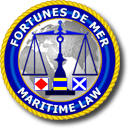Newsletter
Last published articles
A Lire Ailleurs
Calendar
Login
March 2013
19 March 2013
Lexique Poétique Maritime
- Article Details
- Published on 19 March 2013
- Category Publications
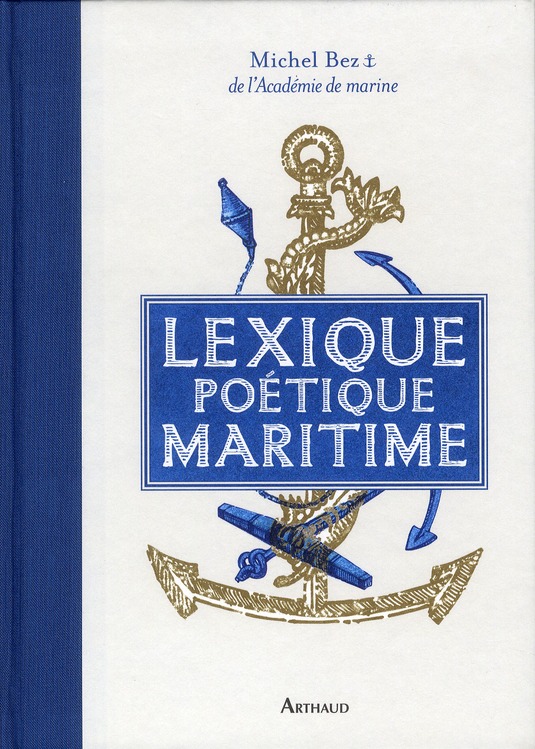 Petite parenthèse littéraire à l'occasion du Salon du Livre pour évoquer ce livre qui nous a véritablement séduit. Comme je l'évoquais récemment sur le réseau social tout bleu, il m'est impossible de passer ne serait-ce que quelques heures à Brest sans faire une petite escale à la librairie Dialogues, ancrée Rue de Siam depuis des années. Lors de mon dernier passage il y a quelques jours je n'ai donc pas déroger à cette règle et je m'y suis attardé de longues minutes, notamment et principalement aux rayons "Mer & Voyages" et "Bande Dessinée". Parmi les dizaines de livres du rayon "Mer et Voyages", un petit livre à l'allure un peu surannée, de part sa reliure en toile et par la police de caractère utilisée sur le dos, a quasi immédiatement attiré mon attention, coincé entre deux autres livres plus classiques sur les phares et les côtes bretonnes.
Petite parenthèse littéraire à l'occasion du Salon du Livre pour évoquer ce livre qui nous a véritablement séduit. Comme je l'évoquais récemment sur le réseau social tout bleu, il m'est impossible de passer ne serait-ce que quelques heures à Brest sans faire une petite escale à la librairie Dialogues, ancrée Rue de Siam depuis des années. Lors de mon dernier passage il y a quelques jours je n'ai donc pas déroger à cette règle et je m'y suis attardé de longues minutes, notamment et principalement aux rayons "Mer & Voyages" et "Bande Dessinée". Parmi les dizaines de livres du rayon "Mer et Voyages", un petit livre à l'allure un peu surannée, de part sa reliure en toile et par la police de caractère utilisée sur le dos, a quasi immédiatement attiré mon attention, coincé entre deux autres livres plus classiques sur les phares et les côtes bretonnes.
Ce livre a littéralement agi comme un aimant dès que je l'ai ouvert. Tout mon imaginaire maritime y était : Les poêmes, l'histoire, les mythes, la mythologie, les objets de la mer et des navires, la religion, le tout superbement illustré en bleu et or, donnant un charme fou à cet ouvrage dont je me suis demandé pourquoi il aura fallu attendre 2011 pour qu'un auteur nous le livre et 2013 pour que je le découvre. Sans doute le charme des "vraies" librairies ou l'on peut à la fois découvrir de véritables trésors en flânant dans les rayons, et passer à côté d'autres pendant des années, sans jamais les voir. Bref, le genre de livres que l'on ne quitte plus une fois qu'il est entre vos mains, de peur qu'un autre marin immobile ne vous le prenne et se l'accapare.
Tout le livre pousse aux rèves, aux pensées solitaires, à ces moments de calme au bord de la mer ou l'on se prend à réver de mythes et de légendes, de sirènes et de navires fantômes, de monstres marins ou de dieux antiques qui sommeilleraient sous le sable. Pour se mettre dans l'ambiance, le livrre débute avec un extrait d'un poème d'Emile Verhaeren.
Ma peau , mes mains et mes cheveux
Sentent la mer
Et sa couleur est dans mes yeux;
Et c'est le flux et le jusant
Qui sont le rythme de mon sang !"
Cette simple strophe nous a complètement séduit. Dans ces conditions, comment ne pas poursuivre la lecture de ce livre qui, au fil des pages, nous fait découvrir l'histoire des symboles marins et à laquelle nous invite l'auteur de cet ouvrage, Michel Bez. Celui-ci, peintre officiel de la Marine (dont il préside l'association depuis 2002), est un éminent membre de l'Académie de Marine et un fin connaisseur du monde maritime. Les océans et ses légendes ont dès lors logiquement nourri son inspiration avant de l'interroger. Pierres angulaires des récits de mythologie, les symboles marins le passionnent au point de lui faire mener une savante enquête.
C'est donc armé de sa «science», de sa plume et de ses pinceaux que l'artiste-peintre et écrivain a voulu inciter ses lecteurs à plonger avec lui dans les océans et leurs mythes. Sans prétention, ni circonvolution, mais avec quelques gouttes (salées) de philosophie, l'auteur inspiré (des textes et des illustrations) nous raconte avec poésie ses légendes puisées aux quatre coins du monde ou ses termes familiers que l'on croyait si bien connaître comme ancre, croix du sud, marée, vague, etc... Ressuscitent des îles mystérieuses, des monstres des profondeurs, des terres englouties ou des navires fantômes.
L'ouvrage phare d'un amoureux des océans et des marins. Un lexique indispensable à compulser au coin du feu, ou mieux dans les fauteuils mœlleux du carré...
Vous l'aurez compris, ce livre fait désormais partie de mes favoris, et je vous invite à le découvrir au plus vite ici.
18 March 2013
Les Ecrans de la Mer à Dunkerque
- Article Details
- Published on 18 March 2013
- Category News
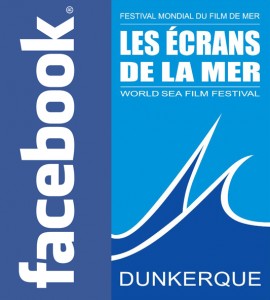 Petit parentèse culturelle pour évoquer en quelques lignes le festival "Les Ecrans de la Mer" qui se déroulera à Dunkerque du 6 au 8 juin 2013. Pour sa troisième édition, le festival vivra au rythme des plus beaux films documentaires, avec, à l'affiche, trois grands thèmes :
Petit parentèse culturelle pour évoquer en quelques lignes le festival "Les Ecrans de la Mer" qui se déroulera à Dunkerque du 6 au 8 juin 2013. Pour sa troisième édition, le festival vivra au rythme des plus beaux films documentaires, avec, à l'affiche, trois grands thèmes :
- L'écologie et l'exploration marine
- l'aventure et les sports nautiques
- Les métiers de la Mer.
Ces thèmes ne sont bien entendu pas choisis au hasard. Si la mer focalise tous les regards avec les problèmes écologiques actuels (fonte des glaces, montée des eaux, réfugiés climatiques, îles de plastique...), elle joue également un rôle dans les enjeux humains (économiques, politiques, culturels...) concernant nos continents. Mais ces enjeux majeurs demandent à être mieux compris.
La mer est très certainement aujourd'hui un espace unique sur notre planète, un domaine dont l'homme à encore beaucoup à apprendre (faune et flore, chimie, géographie, échanges géo-biologiques...). La mer est donc en cela l'un des terrains les plus riches dans le domaine de l'innovation et de la découverte.
Ce festival donne lieu à une compétition de films. Pour cela, le jury du festival est composé, chaque année, de professionnels du cinéma, des métiers de la mer, des sports et de l'écologie maritime. Six prix viennent récompenser les meilleures réalisations :
- le Jean Bart : grand prix (2 500 €) ;
- le Prix du meilleur film sur l'écologie et l'exploration marine (500 €) ;
- le Prix du meilleur film sur les métiers de la mer (1 500 € doté par le Port de Dunkerque) ;
- le Prix du meilleur film sur l'aventure et les sports nautiques (500 €) ;
- le Prix jeune réalisateur (500 €) ;
- le Prix des jeunes de l'agglomération dunkerquoise (500 €).
Cette année, le festival sera présidé cette année par Franck Bruno, scaphandrier professionnel, moniteur de plongée professionnel, et sportif de haut niveau, et qui est aussi le président de l'association "Bout de vie" qui a pour objet d'aider et d'accompagner les personnes amputées à surmonter leur différence notamment par la valorisation de leur potentiel de vie et du sens du dépassement de soi. Il a notamment traversé l'Atlantique à la rame à l'occasion de l'Atlantic Rowing Race en 2005. Avec son co-équipier et ami Dominique Benassi (13 fois champion du monde handisport de triathlon), ils bouclent le parcours en 54 jours et montent sur la troisième marche du podium.
14 March 2013
CMA-CGM MARCO POLO : Impossible to salve and to tow ? No, but...
- Article Details
- Published on 14 March 2013
- Category News
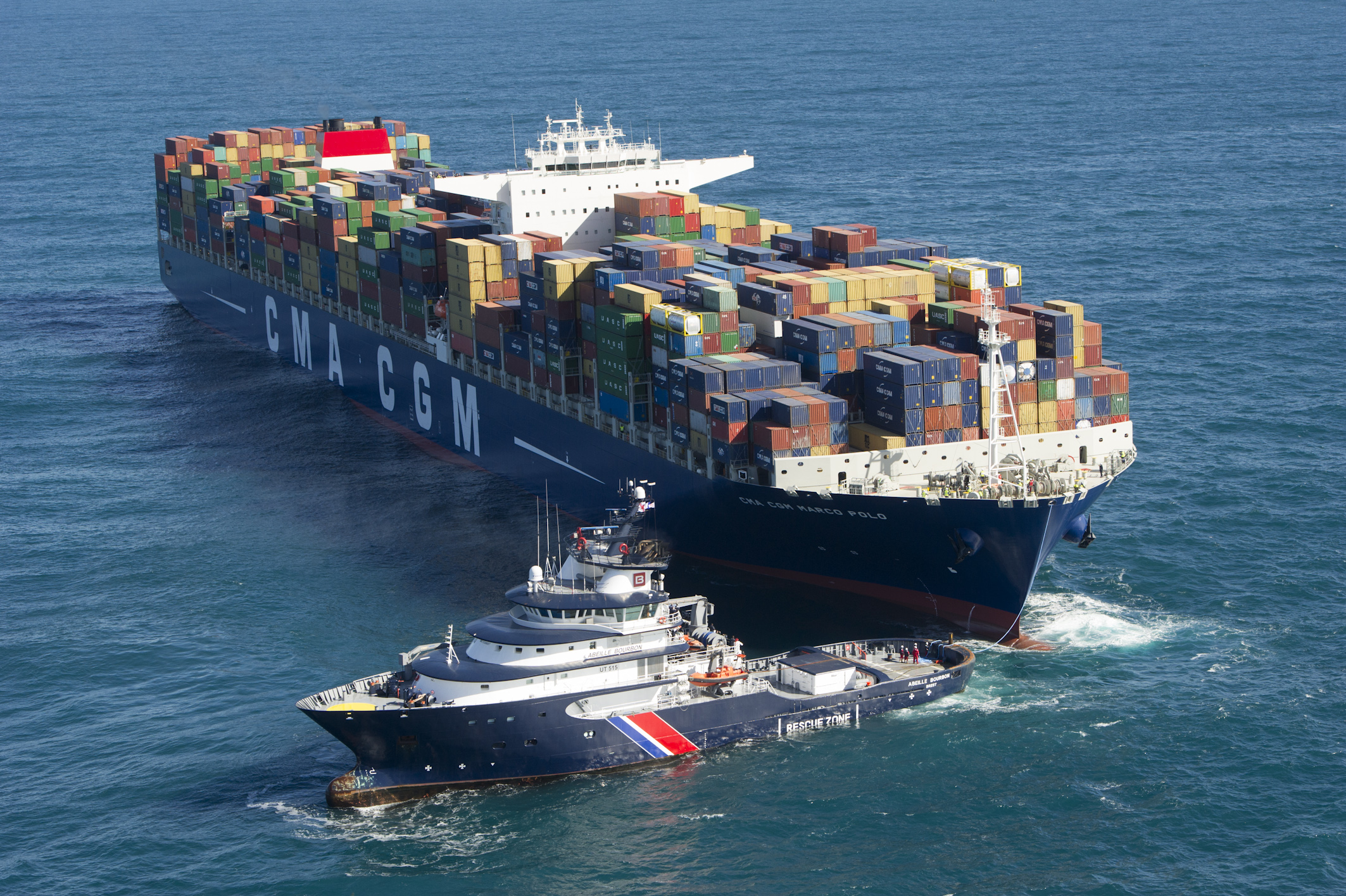 Even if the event took place shortly after our publication on the subject, there is certainly no chance that the exercise has just taken place off the Brittany coats is a direct result of our article related to the potential problems of towing vessels such as the CMA-CGM MARCO POLO.
Even if the event took place shortly after our publication on the subject, there is certainly no chance that the exercise has just taken place off the Brittany coats is a direct result of our article related to the potential problems of towing vessels such as the CMA-CGM MARCO POLO.
Thus, enroute for Asia, CMA-CGM Marco Polo did a little "break" off the coast of Brittany to participate in an exercise organized by the "Prefecture Maritime de l'Atlantique" (depending on Defense Ministry). This administration was indeed concerned whether rescue facilities currently positioned at the tip of Finistère is sufficient to assist, if necessary, the largest commercial ships currently in operation. Because, although the "Abeille Bourbon" and her sister ship the "Abeille Liberté" (units of 80 meters and 209 tons of towing capacity the hook), are probably one o of the most powerful tugs in Europe, shipping industry has continued since their construction in 2005, its race to gigantism. This trend is particularly true for container and cruise ships that are now huge and characterized in particular by a strong wind effect.
The "Préfecture Maritime" therefore wished to train the staff dedicated to rescue and validate, at sea, the theoretical procedures in place to manage an incident (or accident) involving such a giant container ship, which could drift to French coast. It as to be reminded that in such cases, the risk is the shipwreck with the loss of thousands of containers, boxes adrift with many risks for the navigation of other vessels, but also for people should they finally strand on the coast (number of containers contain hazardous materials).
The chosen scenario was an engine breakdown. As soon as it was known from the coastal authorities, a rescue team was transporter by helicopter on board the CMA CGM Marco Polo, whose mission is to assess the situation and prepare rescue operations, in connection the Rescue Coordination Center (this assessment must also be made within the framework of the regulations regarding port refuges). The tug "Abeille Bourbon" sent a towline to the ship of 396 meters long and 53 meters wide (capacity of 16,020 TEUs). After this operation, it was a "normal" towing operation ie stop the Marco Polo, drift of the ship, sending of towing lines, towing the vessel, and finally release and recovery of the towline. "
The REX (Return of Experience) of this exercise is interesting because if the operation on 9 March was a success, the problem of saving this type of vessel has not really found completely satisfactory answers.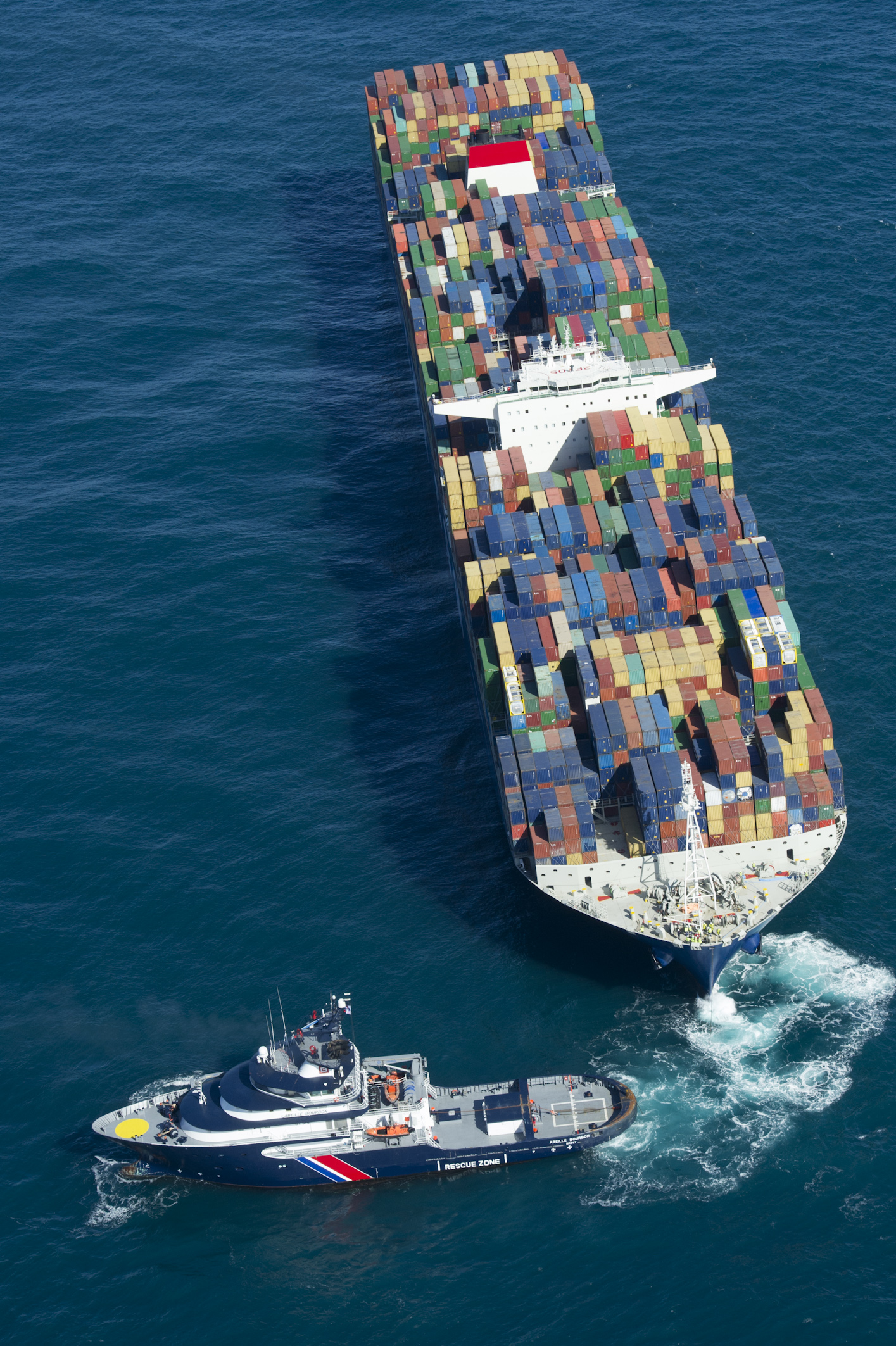 Among the things that can be already retained is that you can have a beautiful weather in Brittany in March (what we say " un temps de curé), including at sea and that weather allowed the Marine Nationale photographers Marine, Alain Monot and Sébastien Deschamps to take stunning images on this operation. I quote willingly their names because many times in the past, I published their photos on this site, without ever specifically mention the author; I attempt to redeem these past mistakes.
Among the things that can be already retained is that you can have a beautiful weather in Brittany in March (what we say " un temps de curé), including at sea and that weather allowed the Marine Nationale photographers Marine, Alain Monot and Sébastien Deschamps to take stunning images on this operation. I quote willingly their names because many times in the past, I published their photos on this site, without ever specifically mention the author; I attempt to redeem these past mistakes.
More seriously, the exercise made me lie, at least partially, in showing that it is indeed possible to tow such sea monsters. But I do not admit me completely defeated because the reference to this beautiful weather (temps de cure) is not so trivial. That the exercise took place in ideal conditions and exceptional is a pleonasm, as they could be radically different at this period of year (as we have few days ago off our coasts and on our roads...).
Also, the weather was probably a little too favorable to perfectly illustrate a "real" situation" and maneuver would surely have been much more complex with an equinox storm. In case of bad weather, and therefore much stronger constraints on the towline and the mooring bitts and fairlead, the towing would have been more difficult. Similarly, the exercise was performed with a ship departing from Europe, that is to say, far from its maximum capacity (the container ships arriving from Asia are full but leave with about 30% or less empty boxes), does not validate the feasibility and reproducibility of the operation.
Some questions remains, especially as it must be recalled that in 2007, the "Abeille Bourbon" and the "Abeille Liberté" were just enough to tow the MSC Napoli (ex-CGM Normandie), which characteristics (275 meters long, 2700 containers) were quite far from the CMA-CGM Marco Polo.
We have to add that the hypothesis of the damage sustained by the vessel was finally the case that pose fewer problems to authorities with this type of vessel. If it remains plausible, the latest examples of major disasters involving ships of this type (MSC NAPOLI or MSC NAPOLI FLAMINIA) showed that the meteorological circumstances or condition of the vessel could to threat attempts to tow or make them particularly difficicult. With regard to the MSC NAPOLI, who suffered from cracks that may at any time cause tearing of the vessel, towing had been shortened and the vessel was voluntarily stranded in a shallow UK bay. For the MSC FLAMINIA, which was partially destroyed by fire and had encountered severe weather conditions, which had no propulsion, it remains the illustration of the total fiasco of the "port refuge" legislation and his application by the coastal States.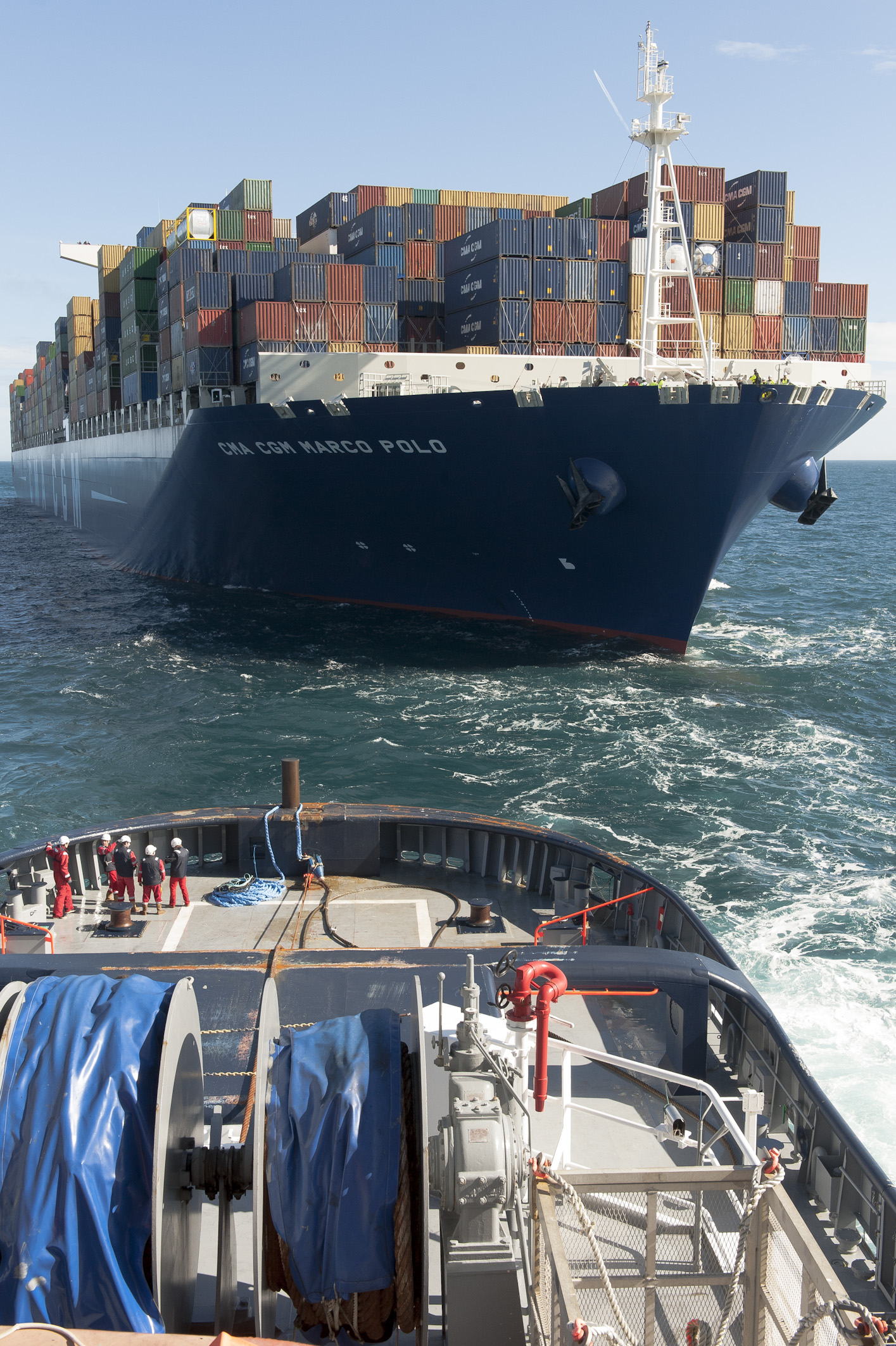 This is why the analysis of the results of the exercise of March 9th will inevitably viewed with a magnifying glass and lead to improve procedures, to better gauge the effectiveness of the equipment according to the different scenarios, and if necessary, strengthen the rescue means in Britain and possibly in the Bay of Biscay, where there is no more ocean salavage tug since the departure of the Abeille Languedoc to the Strait of Pas-de-Calais, in 2011.
This is why the analysis of the results of the exercise of March 9th will inevitably viewed with a magnifying glass and lead to improve procedures, to better gauge the effectiveness of the equipment according to the different scenarios, and if necessary, strengthen the rescue means in Britain and possibly in the Bay of Biscay, where there is no more ocean salavage tug since the departure of the Abeille Languedoc to the Strait of Pas-de-Calais, in 2011.
As emphasized in the web magazine "Mer et Marine", France has been a pioneer and consents major efforts with the largest European ocean salvage network. But these means, from a more or less inevitable and satisfying compromise between risk and financial constaints remain limited compared to some disaster scenarios. They must also be regularly adapted to the evolution of the "threat", as is the case for example with increasing size of vessels in shipping and cruising. While some countries, due to budgetary restrictions, revise downward their resources allocated to rescue the idea made its way to expand this question not only national, but also in Europe. The latter, through the European Maritime Safety Agency (EMSA), created in 2006 following the sinking of the Erika (1999) and Prestige (2002) has already implemented several actions, including the creation of a fleet of ships in charge of depollution. But assistance and towing questions remain managed nationally. However, as we are reminded regularly-and rightly so-the French authorities, the majority of vessels transiting to the UK and Channel are not to or from France. Yet, it is France that ensures alone, or almost, the safety of the traffic, including the economic benefit to foreign ports, including the United Kingdom, the Netherlands, Belgium or Germany ...
To conclude, we could say "Duly noted and next step, next year, in more difficult weather conditions (no steering for example together with no propulsion....) and most importantly, the next ship in distress will have be taken in charge, towed, and bring safely in a port of refuge, an "ambitious program" as may tell our politicians.
© Marine Nationale
09 March 2013
The Lyubov Orlova : A ghost ship in north Atlantic : A new flying dutchman ?
- Article Details
- Published on 9 March 2013
- Category Major cases
.jpg) The maritime world is a fascinating world which provides us with unusual stories, that only the sea has the secret. But these stories can also say a lot about the world in which we live. Undeniably, the Lyubov Orlova story is one of them.
The maritime world is a fascinating world which provides us with unusual stories, that only the sea has the secret. But these stories can also say a lot about the world in which we live. Undeniably, the Lyubov Orlova story is one of them.
Her story is indeed not trivial since this ship has become a ghost ship, lost in the North Atlantic, sometimes spotted, sometimes lost ..... a sort of "flying dutchman" of the twentieth century and also becoming a caricature of excesses and abuses of the maritime world.
The history of the ship began nearly 40 years ago. Ship icebreaker of class mariya Yermolova designed for the Arctic and Antarctic cruises, it was built by the shipyard Brodogadimoste Titovo Kraljevica (now Croatia), on behalf of the Russian company Far Eastern Shipping Company (FESCO). It sails under the flag of Soviet and Russian until August 1996, then fly the Maltese flag for 13 years and finally the Cook Islands from 2009. However, and despite several changes of ownership, it will operated during many years by the same company, Lubov Orlova Shipping Co Ltd who chartered regularly the ship tour operators as Marine Expeditions, Quark Expeditions or Cruise North Expeditions. In 1981 she even received the medal of the Order of Friendship of Nations for participating in a rescue operation.
Apart a grounding in September 2006 on Deception Island in Antarctica, the real troubles for the ship begins at the end of September 2010 when a lien was put on her in the Canadian port of St. John's by his charterer (Cruise North Expeditions) who claimed to the Russian owner the amount of USD 250 000 for cancelled cruises, amount to which it had quickly to add the wages of the 51 crew members, unpaid for several months.
